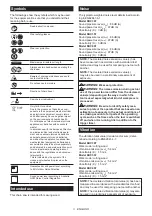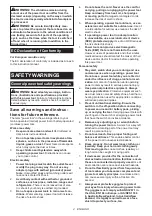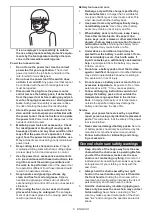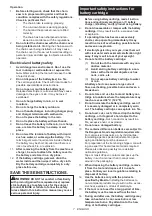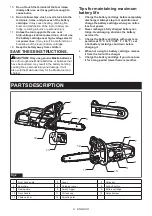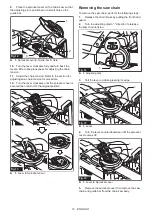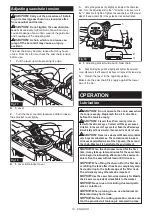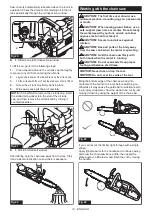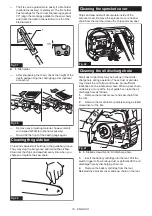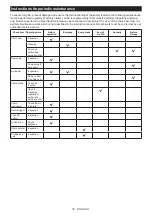
14 ENGLISH
Saw chain is automatically lubricated when the tool is in
operation. Check the amount of remaining oil in the oil
tank periodically through the oil inspection window.
1
2
Fig.20
►
1.
Oil tank cap
2.
Oil inspection window
To fill the oil, perform the following steps:
1.
Clean the area around the oil tank cap thoroughly
to prevent any dirt from entering the oil tank.
2.
Lay the chain saw on its side and remove the oil tank cap.
3.
Fill the oil tank with the oil. The proper amount of oil is 150 ml.
4.
Screw the oil tank cap firmly back in place.
5.
Wipe away any spilt chain oil carefully.
NOTE:
If it is difficult to remove the oil tank cap, insert
the slotted screwdriver into the slot of the oil tank
cap, and then remove the oil tank cap by turning it
counterclockwise.
1
2
Fig.21
►
1.
Slot
2.
Slotted screwdriver
After refilling, hold the chain saw away from the tree. Start
it and wait until lubrication on saw chain is adequate.
Fig.22
Working with the chain saw
CAUTION:
The first time user should, as a
minimum practice, do cutting logs on a saw-horse
or cradle.
CAUTION:
When sawing precut timber, use a
safe support (saw horse or cradle). Do not steady
the workpiece with your foot, and do not allow
anyone else to hold or steady it.
CAUTION:
Secure round pieces against
rotation.
CAUTION:
Keep all parts of the body away
from the saw chain when the motor is operating.
CAUTION:
Hold the chain saw firmly with
both hands when the motor is running.
CAUTION:
Do not overreach. Keep proper
footing and balance at all times.
NOTICE:
Never toss or drop the tool.
NOTICE:
Do not cover the vents of the tool.
Bring the bottom edge of the chain saw body into
contact with the branch to be cut before switching on.
Otherwise it may cause the guide bar to wobble, result-
ing in injury to operator. Saw the wood to be cut by just
moving it down by using the weight of the chain saw.
Fig.23
If you cannot cut the timber right through with a single
stroke:
Apply light pressure to the handle and continue sawing
and draw the chain saw back a little; then apply the
spike bumper a little lower and finish the cut by raising
the handle.
Fig.24



